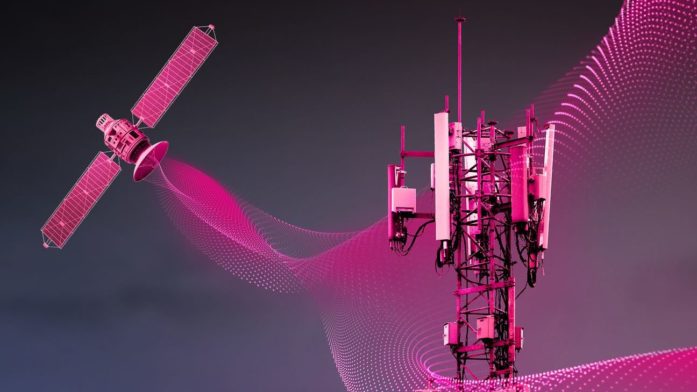MWC 2023, Barcelona. Cellular will now find your IoT sensor in “every warehouse, farmhouse, outhouse, and doghouse”, to (mis)quote Deputy Marshal Samuel Gerard; Deutsche Telekom has said it is working with Intelsat and Skylo to offer a satellite extension to its terrestrial cellular IoT coverage from next quarter. The German telco reckons it will be able to provide IoT connectivity everywhere as a result, including in its home territories and roaming territories via standard cellular, plus in every ‘black-spot’ and ‘not spot’ where terrestrial cellular does not reach.
Its IoT division, branded Telekom IoT (T-IoT), has a number of live use-case trials on show at MWC in Barcelona this week. These include with Germany-based Lanthan, a developer of aircraft lighting systems for wind farms, broadcast masts, and construction cranes, which is working with Deutsche Telekom and Intelsat to connect IoT sensors in remote turbines – so they “transmit their light signals in a fail-safe manner”, and regulate light pollution.
Its other MWC demo, also leveraging Intelsat, is with data specialist Divirod, which is using satellite-augmented IoT to help enterprises and municipalities to monitor water levels in waterways, erosion in coastal areas, and snowfall on roofs. Satellite-assisted IoT sensors have been deployed to assess storm risks in Florida and protect cultural heritage in Venice. The German Federal Waterways and Shipping Administration (WSV) is also testing this service.
Dennis Nikles, chief executive at T-IoT, said: “With integrating satellite connectivity into our T-IoT offering we are reshaping the future of global IoT networking. Our customers now have a ‘network of networks’́ with ubiquitous connectivity which enables completely new possibilities. For our customers, this means best network connectivity everywhere, one point of contact, maximally simple and comprehensive – T-IoT, we connect everything everywhere.”
A statement said: “[We are] closing the last gaps for truly global IoT… Networking wind turbines in remote regions, recording weather data at risk locations, high-performance broadband on the high seas – all of this will be possible… Worldwide IoT [has] no limits. Areas with low cellular coverage, data transmissions across large expanses of water or in the air – satellite is the answer to these last challenges that [have] stood in the way of global IoT.”
Deutsche Telekom is claiming “gapless” service, “maximum reliability”, and affordability also. It is promising an “attractive” commercial offering in the second quarter, with IoT device and connectivity management for both terrestrial and satellite IoT sensors via its IoT Hub platform. It said: “Appropriate hardware, such as a satellite terminal or router, plus an installation service can be booked as an option.”
Intelsat has been appointed for cellular broadband over satellite; Skylo has been recruited for NB-IoT via satellite. Release 17 of the 5G NR standard by 3GPP means NB-IoT modules can be certified for non-terrestrial network (NTN) functionality, switching “autonomously and seamlessly” between terrestrial and satellite networks without the need for additional hardware. Deutsche Telekom will open an ‘early adopter’ club at the end of 2023 for developers to test hybrid IoT devices for the first time.

